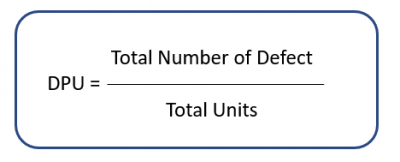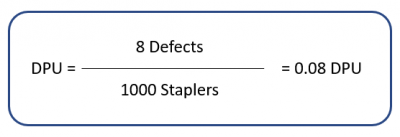
As the new manufacturing engineer for the stapler production line, you find yourself shifting through quality data to get a better understanding of the defect rates involved. One of the reasons you were hired was to measure and analyze the failure rates and hunt down the root cause of any yield issues.
Before trying to tackle the problem, you know that understanding the current state of the quality metrics is necessary to prove that your future work improved the situation. That means you need to know the DPU or defects per unit. Leadership believes there is a quality problem regarding the production line, but do the metrics support that belief?
So, what are the defects per unit of this production line?
An Overview: What Do Defects Per Unit Refer To?
Defects per unit, commonly known as DPU, is a measurement representing the average number of defects that occur with each product unit.
The calculation is the number of defects among a group of products divided by the number of products in the group.

To use an example, let us take a look at a stapler manufacturer. It produced 100 staplers during a shift. Out of that batch, three had one error, one stapler had two errors, and the final stapler had three errors. The remainder of the staplers were error-free. The total number of errors was eight.
To calculate the DPU, take the eight errors and divide the number by 100 (the total quantity of stapler products) to arrive at a value of 0.08 DPU.

This helps establish the average number of errors that will occur per unit. The lower the number, the fewer the anticipated errors and the better the situation.
3 Benefits of Attending to Defects Per Unit
Can Help You Quickly Set Expectations
DPU is easy to calculate. As long as you are collecting information regarding defects, and know your total production numbers, it takes no time at all to generate the value. Take care in understanding what is considered a defect.
Easy to Understand
DPU is a clear metric to use for measuring quality situations, especially at the lower levels. It is often used by quality departments to quantify and justify process improvement efforts.
Accounts for Multiple Defects Per Unit of Production
Unlike some other quality metrics, DPU accounts for multiple defects per unit of production, thus giving a more complete view of a process.
3 Defects Per Unit Best Practices
Keep in mind that this measurement does not do a good job of understanding whether multiple different errors are happening to a handful of units, or if there is a singular consistent error happening to a larger subset of units.
Other defect measurements to use in conjunction with defects per unit include defects per opportunity, defects per million opportunities, and parts per million (units defective). Note that the product or service provided is the unit, while customer specifications such as size, shape, material, and timeliness are opportunities.
Be sure to understand what constitutes a defect. In general, a defect is defined as a property of the product or service that does not meet customer specifications.
Other Useful Tools and Concepts
Looking for some extra info to get your production line moving? Developing effective metrics can be difficult. However, when you have the right baselines and measurements in place, you can see transformations take place within your organization.
Additionally, it might help to take notice of how to convert between DPMO, Sigma, and Cpk. We’ve got a handy guide that covers the ins and outs of these complementary metrics, allowing you to focus on what truly matters in your production line.
Conclusion
Defects per unit is a quick and relatively painless metric to calculate and monitor regarding defects. It is a metric that gives a basic understanding of how often we can expect a product to possess a defect. Monitoring different time periods allows for an understanding of whether quality is improving or worsening over time. When used in conjunction with other quality metrics, it can help give a clear picture of the quality of product being produced, or service being provided.